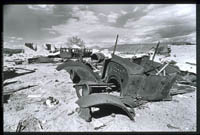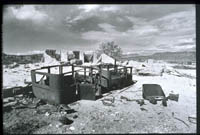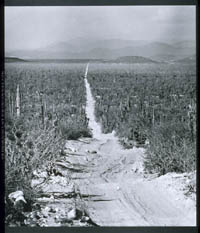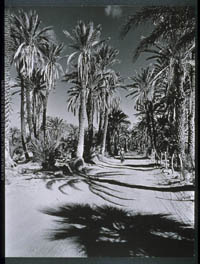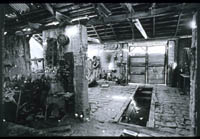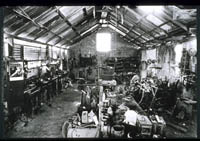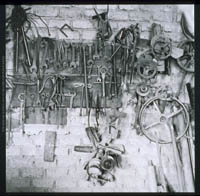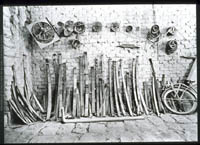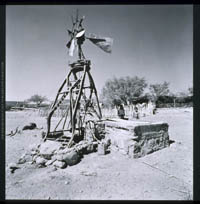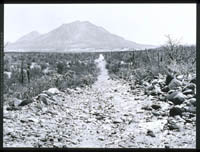|
|
Laguna Seca de Chapala
...continued
- Hulks
of old cars at Calmallí, 1971.
Although placer gold was discovered here in 1882 and the "boom"
was over by 1910, a few individuals continued to work here, at least
intermittently, through the 1930s. By the time of my first visit
in 1967, Calmallí was deserted and the landscape was littered
with ruins of stamp mills, adobe houses and stores, and, most strikingly,
the carcasses of cars dating from the 1920s.
- Hulks
of old cars at Calmallí, 1967.
- Stretch
of the old dirt road near Rancho del Tablón, 1971.
Occasionally the old road crossed level ground, a mesa or an alluvial
plain, and at first glimpse seemed to offer a welcome stretch of
comfort, a relief from turns and bumps. But, on actual encounter,
such notions were dispelled by racking ruts, suffocating dust, exposed
rocks, or jolting washboard. The order of the day, every day, was
eyes on the road- not the distant road, but that part about to disappear
beneath the nose of your vehicle.
- Old
road into San Ignacio, 1971
San Ignacio was the most idyllic oasis a southbound traveler would
encounter in the length of the peninsula. Since he left El Rosario,
now 330 hard miles behind, he had seen no town, no store, no mechanic,
no appreciable body of fresh water. Suddenly, he was wending his
way on a lane that crossed a dammed lake full of rushes and proceeding
through a grove of palms to find all the missing amenities. More
than that, after the rigors of the road, it was a place of calm
that seemed positively urban. Colonial architecture, throngs of
people, schools, shops, and stalls met the eye.
|
|
|
Frank Fischer's Garage
in San Ignacio
As amazing as
anything in San Ignacio was Frank Fischer's machine shop and garage-and
Frank Fischer himself. After an apprenticeship in his native Germany,
Frank got a job as a machinist on a German freighter. In 1910, when
his vessel put in at Santa Rosalia to load partially refined copper
ore, Frank jumped ship and made his way to San Ignacio where he hoped
to hide until his ship departed. He ran out of food and appealed to
a young woman who came near his hiding place to do her family's wash.
In secret, she supplied him until he was able to reveal himself. His
skills were needed and valued in San Ignacio. He married his benefactress
and gradually assembled a collection of ancient but serviceable machines
and tools. He also accumulated a remarkable cache of auto parts and
became a vital part of the system in which old trucks plied the punishing
peninsular highway. In time, Frank Fischer also became a hero to many
tourists stranded anywhere near San Ignacio with auto repair needs.
Frank was a small, slim, intensely active man who learned to speak
excellent Spanish and English. In his later years, his son Oscar,
who had learned at his side, relieved him of most mechanic's chores,
but Don Franky, as he was called, still enjoyed making parts, usually
cutting down or converting one thing to serve another need. Frank
died in 1970, aged about 84, and his son took over the business, converting
it soon afterward into a motel.
- Frank
Fischer's Garage in San Ignacio.
- Frank
Fischer's Garage in San Ignacio.
- Frank
Fischer's Garage in San Ignacio.
- Frank
Fischer's Garage in San Ignacio.
- Windmill
pump built from auto parts near San Ignacio, 1972
Peninsular California has never been known for indigenous folk art;
some might argue that such does not exist, or at best represents
traditions imported from other parts of Mexico. But, here and there,
unselfconscious assemblages of materials, intended to be utilitarian,
seem to make artistic statements- art in the eye of the beholder.
- Old
road from San Ignacio to Santa Rosalía, 1975.
Some parts of the paved highway opened in 1973 lay over and obliterated
the old dirt road. Elsewhere, long or short stretches survive, usually
entirely abandoned. Here is one such, still paralleled by the telegraph
line precariously draped on poles cut from local palo blanco trees.
Dust thou art....
|

